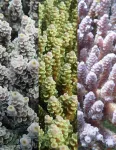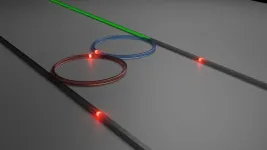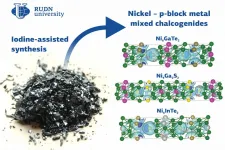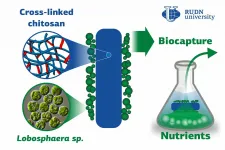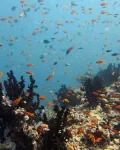Bioengineered hybrid muscle fiber for regenerative medicine
Regeneration of muscle tissue was achieved by combining direct cell reprogramming with natural-synthetic hybrid scaffold as structural support
2021-02-22
(Press-News.org) Muscle is the largest organ that accounts for 40% of body mass and plays an essential role in maintaining our lives. Muscle tissue is notable for its unique ability for spontaneous regeneration. However, in serious injuries such as those sustained in car accidents or tumor resection which results in a volumetric muscle loss (VML), the muscle's ability to recover is greatly diminished. Currently, VML treatments comprise surgical interventions with autologous muscle flaps or grafts accompanied by physical therapy. However, surgical procedures often lead to a reduced muscular function, and in some cases result in a complete graft failure. Thus, there is a demand for additional therapeutic options to improve muscle loss recovery.
A promising strategy to improve the functional capacity of the damaged muscle is to induce de novo regeneration of skeletal muscle via the integration of transplanted cells. Diverse types of cells, including satellite cells (muscle stem cells), myoblasts, and mesenchymal stem cells, have been used to treat muscle loss. However, invasive muscle biopsies, poor cell availability, and limited long-term maintenance impede clinical translation, where millions to billions of mature cells may be needed to provide therapeutic benefits.
Another important issue is controlling the three-dimensional microenvironment at the injury site to ensure that the transplanted cells properly differentiate into muscle tissues with desirable structures. A variety of natural and synthetic biomaterials have been used to enhance the survival and maturation of transplanted cells while recruiting host cells for muscle regeneration. However, there are unsolved, long-lasting dilemmas in tissue scaffold development. Natural scaffolds exhibit high cell recognition and cell binding affinity, but often fail to provide mechanical robustness in large lesions or load-bearing tissues that require long-term mechanical support. In contrast, synthetic scaffolds provide a precisely engineered alternative with tunable mechanical and physical properties, as well as tailored structures and biochemical compositions, but are often hampered by lack of cell recruitment and poor integration with host tissue.
To overcome these challenges, a research team at the Center for Nanomedicine within the Institute for Basic Science (IBS) in Seoul, South Korea, Yonsei University, and the Massachusetts Institute of Technology (MIT) devised a novel protocol for artificial muscle regeneration. The team achieved effective treatment of VML in a mouse model by employing direct cell reprogramming technology in combination with a natural-synthetic hybrid scaffold.
Direct cell reprogramming, also called direct conversion, is an efficient strategy that provides effective cell therapy because it allows the rapid generation of patient-specific target cells using autologous cells from the tissue biopsy. Fibroblasts are the cells that are commonly found within the connective tissues, and they are extensively involved in wound healing. As the fibroblasts are not terminally differentiated cells, it is possible to turn them into induced myogenic progenitor cells (iMPCs) using several different transcription factors. Herein, this strategy was applied to provide iMPC for muscle tissue engineering.
In order to provide structural support for the proliferating muscle cells, polycaprolactone (PCL), was chosen as a material for the fabrication of a porous scaffold due to its high biocompatibility. While salt-leaching is a widely used method to create porous materials, it is mostly limited to producing closed porous structures. To overcome this limitation, the researchers augmented the conventional salt leaching method with thermal drawing to produce customized PCL fiber scaffolds. This technique facilitated high-throughput fabrication of porous fibers with controlled stiffness, porosity, and dimensions that enable precise tailoring of the scaffolds to the injury sites.
However, the synthetic PCL fiber scaffolds alone do not provide optimal biochemical and local mechanical cues that mimic muscle-specific microenvironment. Hence the construction of a hybrid scaffold was completed through the incorporation of decellularized muscle extracellular matrix (MEM) hydrogel into the PCL structure. Currently, MEM is one of the most widely used natural biomaterials for the treatment of VML in clinical practice. Thus, the researchers believe that hybrid scaffolds engineered with MEM have a huge potential in clinical applications.
The resultant bioengineered muscle fiber constructs showed mechanical stiffness similar to that of muscle tissues and exhibited enhanced muscle differentiation and elongated muscle alignment in vitro. Furthermore, implantation of bioengineered muscle constructs in the VML mouse model not only promoted muscle regeneration with increased innervation and angiogenesis but also facilitated the functional recovery of damaged muscles. The research team notes: "The hybrid muscle construct might have guided the responses of exogenously added reprogrammed muscle cells and infiltrating host cell populations to enhance functional muscle regeneration by orchestrating differentiation, paracrine effect, and constructive tissue remodeling."
Prof. CHO Seung-Woo from the IBS Center for Nanomedicine and Yonsei University College of Life Science and Biotechnology who led this study notes: "Further studies are required to elucidate the mechanisms of muscle regeneration by our hybrid constructs and to empower the clinical translation of cell-instructive delivery platforms."
INFORMATION:
[Attachments] See images for this press release:
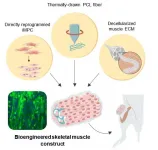
ELSE PRESS RELEASES FROM THIS DATE:
2021-02-21
Coral within the family Acropora are fast growers and thus important for reef growth, island formation, and coastal protection but, due to global environmental pressures, are in decline
A species within this family has three different color morphs - brown, yellow-green, and purple, which appear to respond differently to high temperatures
Researchers looked at the different proteins expressed by the different color morphs, to see whether these were related to their resilience to a changing environment
The green variant was found to maintain high levels of green fluorescent proteins during summer heatwaves and was less likely to bleach than the other two morphs
This suggest that resistance to thermal stress is influenced by a coral's underlying genetics, ...
2021-02-20
Periodic pulses of light forming a comb in the frequency domain are
widely used for sensing and ranging. The key to the miniaturisation of
this technology towards chip-integrated solutions is the generation of
dissipative solitons in ring-shaped microresonators. Dissipative solitons
are stable pulses circulating around the circumference of a nonlinear
resonator.
Since their first demonstration, the process of dissipative soliton
formation has been extensively studied and today it is rather
considered as textbook knowledge. Several directions of further
development are ...
2021-02-20
A survey by a Boston University researcher of nearly 33,000 college students across the country reveals the prevalence of depression and anxiety in young people continues to increase, now reaching its highest levels, a sign of the mounting stress factors due to the coronavirus pandemic, political unrest, and systemic racism and inequality.
"Half of students in fall 2020 screened positive for depression and/or anxiety," says END ...
2021-02-19
Microorganisms possess natural product biosynthetic gene clusters (BGCs) that may harbor unique bioactivities for use in drug development and agricultural applications. However, many uncharacterized microbial BGCs remain inaccessible. Researchers at University of Illinois Urbana-Champaign previously demonstrated a technique using transcription factor decoys to activate large, silent BGCs in bacteria to aid in natural product discovery.
Now, they have developed a direct cloning method that aims to accelerate large-scale discovery of novel natural products. Their findings are reported in the journal Nature Communications.
Named Cas12a assisted precise targeted cloning using in vivo Cre-lox recombination (CAPTURE), ...
2021-02-19
DURHAM, N.C. -- Duke researchers have been studying something that happens too slowly for our eyes to see. A team in biologist Philip Benfey's lab wanted to see how plant roots burrow into the soil. So they set up a camera on rice seeds sprouting in clear gel, taking a new picture every 15 minutes for several days after germination.
When they played their footage back at 15 frames per second, compressing 100 hours of growth into less than a minute, they saw that rice roots use a trick to gain their first foothold in the soil: their growing tips make ...
2021-02-19
A chemist from RUDN University, working with a group of colleagues, synthesized three new chalcogenides (compounds that contain metals and elements from group 16 of the periodic table). The team suggested an unusual approach to synthesis that was based on iodine. An article about the work was published in the Dalton Transactions journal.
Chalcogens are elements of group 16 of the periodic table that include oxygen, sulfur, selenium, tellurium, polonium, and livermorium--an artificial radioactive element. Chalcogenides are compounds of chalcogens with metals that are used as photosensitive ...
2021-02-19
Several University of Illinois Chicago faculty members have addressed the issue of how to ethically conduct research with Black populations.
In their paper "Ethics of Research at the Intersection of COVID-19 and Black Lives Matter: A Call to Action," authors Natasha Crooks, an assistant professor, Phoenix Matthews, a professor, both of the UIC College of Nursing, and Geri Donenberg, director of the Center for Dissemination and Implementation Science at the UIC College of Medicine, highlight the historical issues that impact research involving Black populations. They also provide recommendations for researchers to ethically engage Black populations in research. ...
2021-02-19
Biotechnologists from RUDN University in collaboration with Lomonosov MSU and Kurchatov institute made an important contribution to the technology of phosphate and nitrate biocapture from wastewater using Lobosphaera algae fixed on the filters.The biomass obtained in the course of this process can be used as a fertilizer. The results of the study were published in the Journal of Water Process Engineering.
Phosphates and nitrates get to the wastewater together with industrial and household waste, especially detergents. Both substances are parts of phosphorus and nitrogen chemical cycles. However, these cycles are disturbed by human activity, as the growing amounts of phosphates and nitrates cannot be processed by water ecosystems. As a result, these substances turn from useful nutrients ...
2021-02-19
New Orleans, LA - A retrospective study conducted by LSU Health New Orleans reports that contrary to previous research, most patients who drop out of peritoneal dialysis may do so for psychosocial reasons. The findings are published in The American Journal of the Medical Sciences, available here. The paper inspired a companion editorial, available here.
The research team evaluated the reasons that 27 of the 83 patients enrolled in the peritoneal dialysis program withdrew between 2016 and 2018. Twenty-four or 86% were African American. They found that psychosocial factors, including mental health illness such as anxiety and depression, loss of support networks, or inability to tolerate ...
2021-02-19
Since Charles Darwin's day, the abundance of life on coral reefs has been puzzling, given that most oceanic surface waters in the tropics are low in nutrients and unproductive.
But now research, led by Newcastle University and published in in the journal Science Advances, has confirmed that the food web of a coral reef in the Maldives relies heavily on what comes in from the open ocean.
The team found that these offshore resources contribute to more than 70% of reef predator diets, the rest being derived from reef associated sources.
Led by Dr Christina Skinner, now based at the Hong Kong University of Science and Technology, the researchers included collaborators from Woods Hole Oceanographic Institution (USA), Banyan Tree Marine ...
LAST 30 PRESS RELEASES:
[Press-News.org] Bioengineered hybrid muscle fiber for regenerative medicine
Regeneration of muscle tissue was achieved by combining direct cell reprogramming with natural-synthetic hybrid scaffold as structural support

